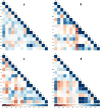Differential elemental uptake in three pseudo-metallophyte C4 grasses in situ in the eastern USA
- PMID: 28845059
- PMCID: PMC5568086
- DOI: 10.1007/s11104-017-3198-9
Differential elemental uptake in three pseudo-metallophyte C4 grasses in situ in the eastern USA
Abstract
Background and aims: Elemental uptake in serpentine floras in eastern North America is largely unknown. The objective of this study was to determine major and trace element concentrations in soil and leaves of three native pseudo-metallophyte C4 grasses in situ at five sites with three very different soil types, including three serpentine sites, in eastern USA.
Methods: Pseudo-total and extractible concentrations of 15 elements were measured and correlated from the soils and leaves of three species at the five sites.
Results: Element concentrations in soils of pseudo-metallophytes varied up to five orders of magnitude. Soils from metalliferous sites exhibited higher concentrations of their characteristic elements than non-metalliferous. In metallicolous populations, elemental concentrations depended on the element. Concentrations of major elements (Ca, Mg, K) in leaves were lower than typical toxicity thresholds, whereas concentrations of Zn were higher.
Conclusions: In grasses, species can maintain relatively low metal concentrations in their leaves even when soil concentrations are richer. However, in highly Zn-contaminated soil, we found evidence of a threshold concentration above which Zn uptake increases drastically. Finally, absence of main characteristics of serpentine soil at one site indicated the importance of soil survey and restoration to maintain serpentinophytes communities and avoid soil encroachment.
Keywords: C4 grass; Calamine; Pseudo-metallophytes; Serpentine; accumulation; excluder.
Figures




Similar articles
-
Traffic-related trace element accumulation in roadside soils and wild grasses in the Qinghai-Tibet Plateau, China.Int J Environ Res Public Health. 2013 Dec 30;11(1):456-72. doi: 10.3390/ijerph110100456. Int J Environ Res Public Health. 2013. PMID: 24380977 Free PMC article.
-
Element accumulation, distribution, and phytoremediation potential in selected metallophytes growing in a contaminated area.Environ Monit Assess. 2015 Jul;187(7):441. doi: 10.1007/s10661-015-4680-6. Epub 2015 Jun 19. Environ Monit Assess. 2015. PMID: 26088758
-
Mineral characteristics of leaves of plants from different phylogeny grown in various soil types in the temperate region.Plant Foods Hum Nutr. 2003 Spring;58(2):117-37. doi: 10.1023/a:1024419130413. Plant Foods Hum Nutr. 2003. PMID: 12906351
-
Divergent biology of facultative heavy metal plants.J Plant Physiol. 2017 Dec;219:45-61. doi: 10.1016/j.jplph.2017.08.014. Epub 2017 Sep 7. J Plant Physiol. 2017. PMID: 29028613 Review.
-
Are Grasses Really Useful for the Phytoremediation of Potentially Toxic Trace Elements? A Review.Front Plant Sci. 2021 Nov 24;12:778275. doi: 10.3389/fpls.2021.778275. eCollection 2021. Front Plant Sci. 2021. PMID: 34917111 Free PMC article. Review.
Cited by
-
Framework for assessment and phytoremediation of asbestos-contaminated sites.Environ Sci Pollut Res Int. 2017 Nov;24(33):25912-25922. doi: 10.1007/s11356-017-0177-x. Epub 2017 Sep 22. Environ Sci Pollut Res Int. 2017. PMID: 28940054 Free PMC article.
References
-
- Alexander EB. Serpentine Geoecology of the eastern and southeastern margins of North America. Northeast Nat. 2009;16:223–252. doi: 10.1656/045.016.0518. - DOI
-
- Alloway BJ. Sources of Heavy Metals and Metalloids in Soils. In: Alloway BJ, editor. Heavy Metals in Soils. Springer; Netherlands: 2013. pp. 11–50.
-
- Arabas KB. Spatial and temporal relationships among fire frequency, vegetation, and soil depth in an eastern north American serpentine barren. J Torrey Bot Soc. 2000;127:51–65. doi: 10.2307/3088747. - DOI
Grants and funding
LinkOut - more resources
Full Text Sources
Other Literature Sources
Miscellaneous
